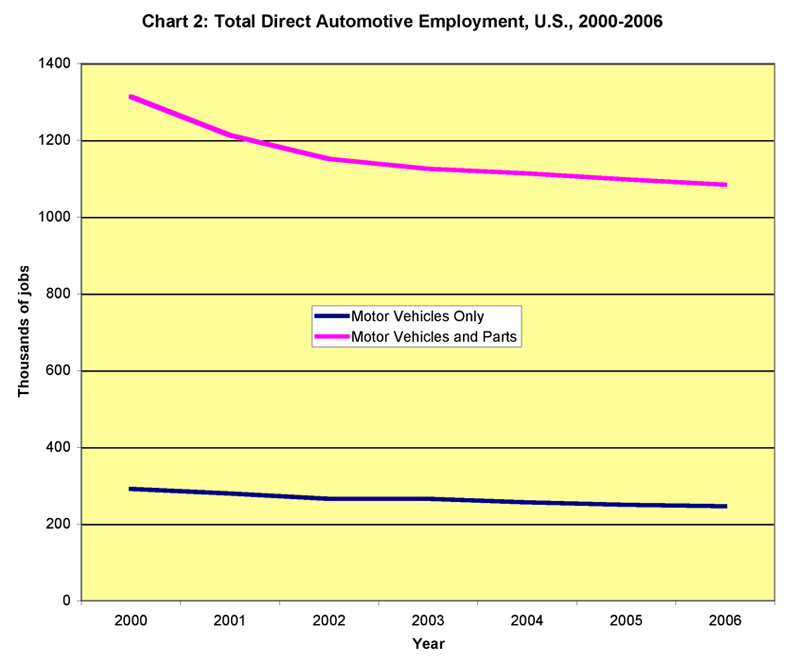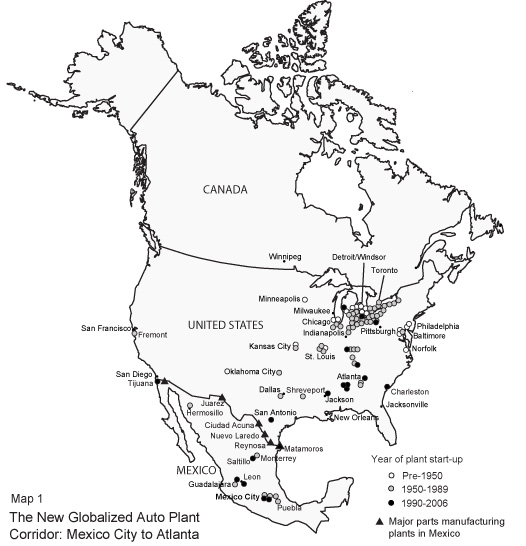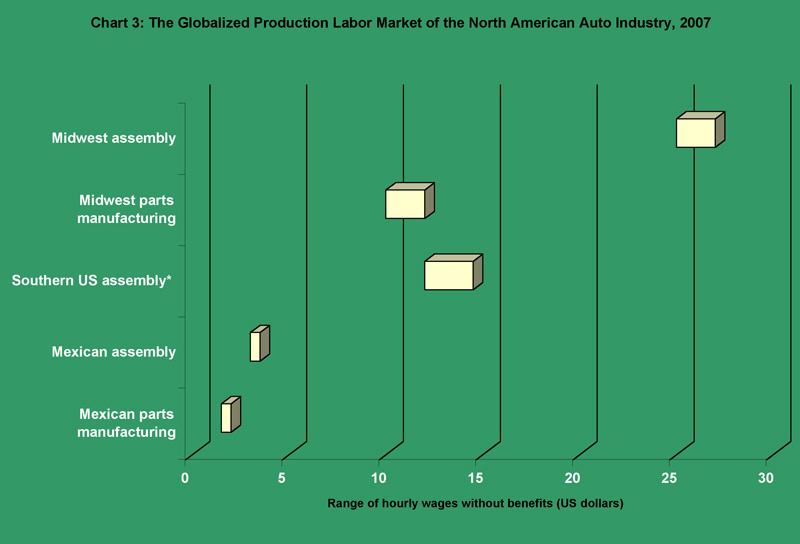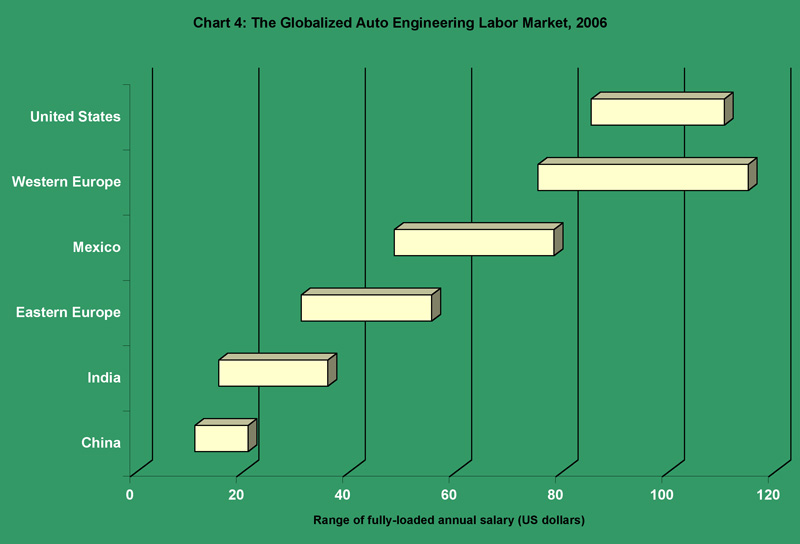Understanding globalization, the main trend of capitalism at the beginning of the 21st century, is critical because of the many ways that it is undermining the lives and communities of working people in North America and around the world. Few industries in the developed nations that are not specifically location-bound have been able to resist the appeal of cheap offshore labor to maximize profits, and the North American automobile industry is no exception.
Although tackling the issue of globalization is a challenging task, it is not as daunting as it might at first appear. Two salient facts about global production clarify the issue:
The first of these facts is established by dispelling the widely held misconception that in modern capitalist production, because of the magnitude of capital investment and the widespread application of technology, the role of labor has diminished almost to the point of insignificance. The fact that the labor costs involved in current commodity production in many industries is 15 percent or less of total costs is cited as conclusive evidence of labor’s negligible contribution.
Close analysis reveals that the opposite is true; labor costs continue to be the primary factor in determining the profit rate in most industries. A comparison of two simple scenarios explains why.
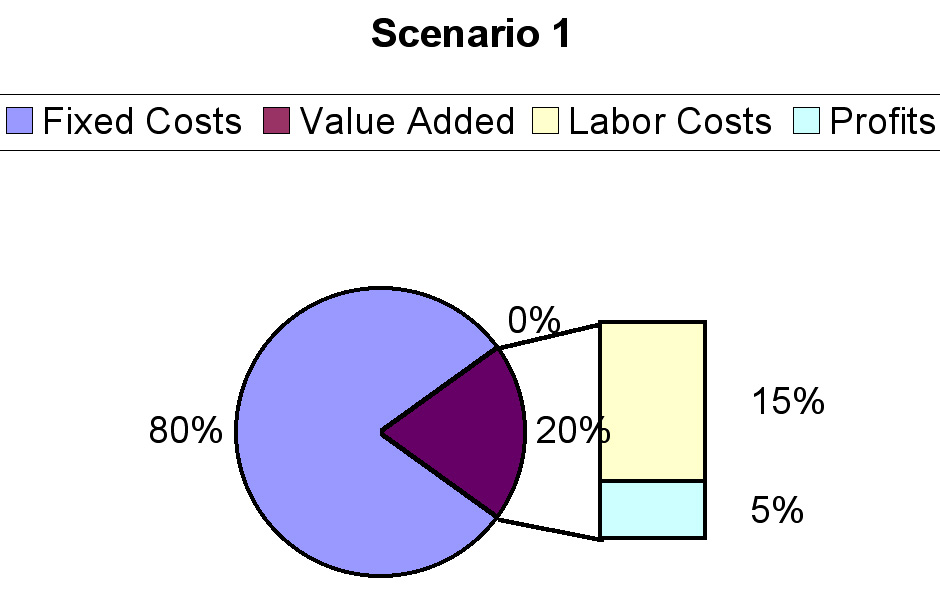 |
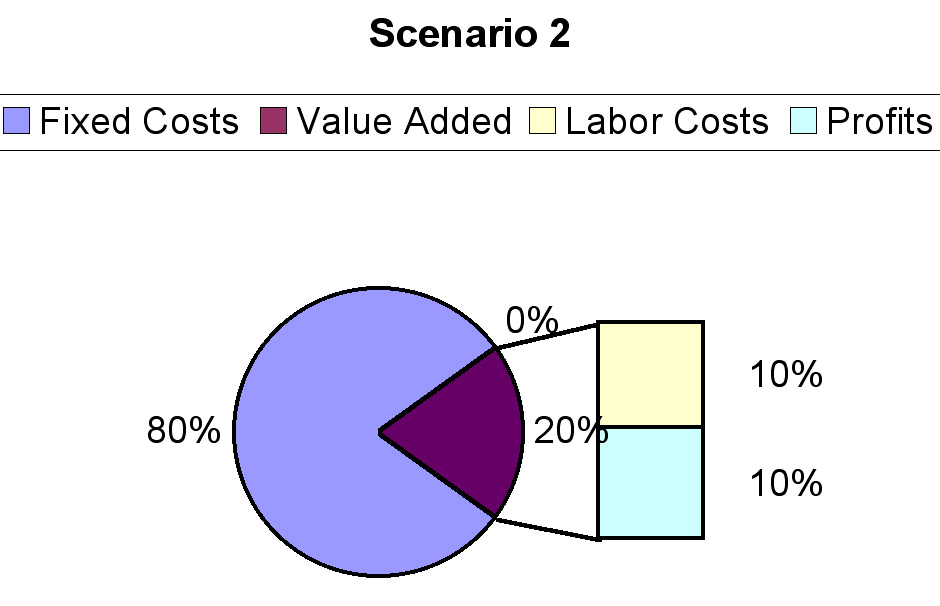 |
In chart 1, scenarios 1 and 2, which represent the value of the same commodity produced with different labor costs, appear similar under cursory examination — both show the same high ratio of fixed costs of production (80 percent) to value added (20 percent). The critical difference between the scenarios appears in the breakdown of value added. In scenario 1, 15 percent of the value of the commodity is accounted for by labor costs, while in scenario 2 the labor costs have been reduced to 10 percent. Correspondingly, profits from the production of the commodity in scenario 1 are only 5 percent of the total value, while profits on the same commodity in scenario 2 represent 10 percent. Comparison between scenarios 1 and 2 shows that a 33.3 percent reduction in labor costs doubles the profit on the same commodity.
Recognizing this critical relationship between labor costs and profitability in modern capitalist production is a key to understanding globalization — setting up runaway plants and offshoring production in order to exploit cheap labor markets is a primary means of reducing aggregate labor costs and securing higher profits for the owners of capital.
The second salient fact of globalization is that value is added to a commodity at each stage of a production chain, no matter where the operation takes place, allowing capitalism to suppress the aggregate labor costs of commodities by developing global production chains that exploit the cheapest labor available regardless of international boundaries.
Capitalism’s insatiable demand for cheap labor, no matter where it is located, is the driving force behind the rush to globalization that has trampled upon the rights and welfare of working people everywhere. The automobile industry in North America offers a case study that illustrates the direction that capitalism is taking in the 21stcentury and indicates the consequences of this trend for working people throughout the continent and the world.
The Auto Industry in North America
Automobile production, a cornerstone of the economy of North America for most of the 20th century, is still a key industry in the 21st. Currently, auto production accounts for about 6 percent of the GDP in the U.S., 12 percent in Canada, and is the fastest growing industry in the manufacturing sector of the Mexican economy. While the U.S. is by far the biggest producer of automobiles in North America, it is also the biggest importer. Canada and Mexico are net exporters of autos and auto parts, mostly to the U.S. market.
Free market economic policies and the resulting global production chains that are continuing to expand are revolutionizing the auto industry in North America at the expense of working people, especially those in the Midwest. Chart 2 reflects the impact of recent globalization on autoworker jobs in the U.S.
Chart 2 tracks total direct auto employment in the U.S. from 2000 through 2006. The graph, based on U.S. Department of Labor Statistics reports, shows a significant downward trend in total direct auto employment following the economic recession of 2001. Since 2000, no less than 229,000 automotive jobs, 45,000 in vehicle assembly and 184,000 in parts manufacturing, have been lost.
Chart 2 also highlights the importance of parts manufacturing in the auto industry, consistently accounting for 77 percent of total direct employment throughout the period. This high proportion is comparable in Canada and significantly higher in Mexico where jobs in parts manufacturing accounts for close to 90 percent of total direct automotive employment.
The declines in both motor vehicle and parts manufacturing jobs in the U.S. since peak employment in 2000 reflect both the effects of the 2001 recession and the ongoing attempts by capital to maximize profits through globalization. The substantial decline in parts manufacturing employment, which is also impacting Canadian autoworkers, is the most notable direct consequence of the auto industry’s continuing migration to the South in pursuit of cheaper labor.
Map 1 provides the historical background of the ongoing globalization of the auto industry in North America.
Map 1, which features the new globalized auto plant corridor that extends from Mexico City to Atlanta, charts the historic and continuing migration of the auto industry to the South. This map identifies the major auto plants in North America and differentiates three distinct periods:
- The pre-1950 period, during which the U.S. auto industry was established by the Big Three American automakers (GM, Ford, and Chrysler) in the upper Midwest with a few plants in Mid-Atlantic states.
- The 1950-1989 period, when the U.S. auto industry expanded into Canada and participated in the runaway shop movement to the American South in order to exploit cheaper labor in the segregated, right-to-work states. During this period, automakers also took advantage of the opening of Mexico to foreign industry with the establishment of the maquiladora manufacturing industry. The exploitation of Mexican labor, initiated through the Border Industrialization Program (BIP) in the mid-1960s, marks the beginning of aggressive globalization in North America.
- The 1990-2006 period that witnessed the adoption of NAFTA, the extension of maquiladora manufacturing into the interior of Mexico, and the full-blown globalization of the North American auto industry. It was during this last period that the automakers developed the new southern auto plant corridor that straddles the U.S.-Mexico border and spans 1,800 miles. Twelve of the 18 assembly plants planned for or built in North America during this period are located in this new globalized corridor.
The extent to which neo-conservative free trade policies have opened this southern auto corridor to foreign automakers is another important aspect of the globalization of the North American automobile industry. The impact of these foreign operations in Mexico and the American South on autoworkers in the Midwest, in conjunction with the southern migration of the Big Three, will be discussed below.
Another conspicuous feature of map 1 that deserves particular attention is the concentration of major parts manufacturing plants in northern Mexico along the international border from Tijuana to Matamoros. The location and role of these offshore parts manufacturing operations is critical in maintaining the tiered labor force of the globalized North American auto industry by exploiting political boundaries.
A clear understanding of the function of tiered labor in global production chains is an essential prerequisite for confronting the globalization of the North American automobile industry.
Tiered Labor and Global Production
Modern capitalism’s relentless demand for cheap labor, illustrated by the two scenarios compared in chart 1, is the compelling force behind the globalization of the North America automobile industry. The transnational labor market structure that has been developed by big capital can best be described as a tiered labor supply, justified by free market rhetoric and sanctioned by all of the governments and agencies that have jurisdiction along the global production chain. The primary function of global production chains is to establish and maintain the lowest possible aggregate labor costs in order to maximize profits. To accomplish this goal, workers are divided, both domestically and internationally, into production tiers that are paid grossly unequal wages and receive widely disparate employment benefits. Typically, there are at least three tiers in each link of a production chain.
Tier 1 employees, who hold the top jobs in production chains, enjoy the best wages, employment benefits, and working conditions relative to other workers both inside the chain and in the region where production takes place. In the automobile industry, the majority of tier 1 workers are direct employees of the original equipment manufacturers (OEMs), and most of them work in the plants where the vehicles are assembled and finished. Many automotive tier 1 employees are well-trained workers with advanced information technology (IT) or automation technology (AT) skills.
Tier 2 employees work for subsidiaries of the OEMs or primary contractors that produce goods or provide services for the OEMs. Tier 2 workers usually earn significantly lower wages with fewer benefits and under working conditions inferior to those enjoyed by tier 1 workers. Tier 2 workers are generally less educated than tier 1 workers but in many cases must complete some post-secondary education in order to qualify for employment.
In the auto industry, the majority of the tier 2 employees work for manufacturers of vehicle parts and components. This tier makes up the bulk of the industry labor force (77 percent in the U.S.). Hence, the suppression of the wages and benefits of tier 2 employees lowers the aggregate labor costs substantially.
Tier 3 employees, who work for subcontractors that provide support services for the OEMs, subsidiaries, and primary contractors, occupy the bottom of the production chain as far as wages, working conditions, and benefits go. In the automobile industry, tier 3 workers clean and maintain office and production facilities and grounds, work in cafeterias, laundries, etc. These workers are often part-time employees who work at, or below, minimum wages, receive no benefits, are usually women, and are often illegal immigrants.
Some operations in the automobile industry, like transportation, employ tier 1, 2, and 3 employees working side-by-side. This mixing occurs among truck drivers where common carrier drivers (tier 1, often Teamsters) spot their trucks at assembly plants between OEM company drivers (tier 1 or 2 employees) and contract haulers (tier 2 and, in some cases, tier 3 workers). Tier 3 employees also shuttle and service vehicles on site.
Global production chains are established to develop and exploit specific regional or national labor markets, and the globalization of the North American auto industry is currently following two distinct trends. In the first trend, tier 1 and tier 3 work is performed onshore at southern U.S. locations and as much tier 2 work as is feasible is offshored to Mexico or the Far East. In the second trend, both foreign and domestic-owned OEMs offshore production entirely to Mexico, assembling parts manufactured in Mexico or imported from the Far East and exporting the finished automobiles to the U.S. market. The drive to increase profits by reducing aggregate labor costs is dictating the labor practices in both trends and continuing to undermine autoworkers in the Midwest and Canada.
A close look at the current globalized North American labor market and the status of the two established trends of globalization completes the analysis of the auto industry and suggests that, without a credible challenge, both trends will continue to grow and undercut labor in the North.
The Globalized North American Auto Labor Market
The battle against the globalization of the North American automobile industry promises to be difficult because the trend has a long history and has been accelerating in the last decade and a half. Though the toll has been greatest on production autoworkers, the industry has begun significant offshoring of automotive engineering and white-collar production support work.
Analysis of the current globalized North American auto labor market reveals the extent that globalization is already entrenched in the industry and presents a foreboding employment picture for autoworkers in the North.
Production Autoworkers
Chart 3 illustrates the tiered production labor costs in the North American auto industry in 2007.
The disparity of wages depicted in chart 3, both domestically and transnationally, is staggering. Midwest autoworkers currently enjoy the top wages in the industry at an average of $26/hour. The sliding globalized pay scale is steep — the average pay of Southern U.S. assembly workers is $13.25/hour, slightly over half (51 percent) of the wages of workers in the Midwest. Mexican assembly workers are at the bottom of the scale, currently making an average of $3.25/hour, a paltry 13 percent of the wages of their counterparts in the Midwest.
Chart 3 also shows that the average pay of parts workers (tier 2 workers) is about half that of assembly workers (tier 1 workers) in both countries. Mexican parts workers, making an average of $1.75/hour, are at the lowest end of the tiered labor market of record, making a mere 16 percent of the wages of parts workers in the Midwest ($11/hour average).
The absence of a category for southern U.S. parts manufacturing in chart 3 is accounted for by the fact that southern U.S. assembly plants rely on Mexican factories for the bulk of their parts (see map 1). The proximity of this source of cheap parts is, in fact, a primary determinant of their location.
Data on the earnings of tier 3 workers in the North American auto industry are not officially collected or recorded but are minimum wage or below in both countries.
When the skewed array of tiered hourly wages in chart 3 is considered in light of the labor cost/profit correlation illustrated in chart 1, the heart of the globalization of the North American auto industry is laid bare for all to see.
The impact of the auto industry’s shift to the South on autoworkers and their communities in the Midwest is the central political issue at hand and will be discussed below. At this point, it must be duly noted that the globalization of the auto industry is no longer restricted to the ranks of blue-collar workers — automotive engineers and IT workers are facing the same problems of downsizing and job erosion that have been plaguing production workers.
Automotive Engineers and ITs
While the unrestricted pursuit of profits is shifting auto production to the South, the proximity of the huge U.S. market and high shipping costs have had a tendency to keep the factories on the continent. This is not the case with automotive engineering and numerous auto industry IT and white-collar jobs. Though many aspects of production line engineering require access to the factory, the location of product research and development (R&D) operations is virtually unrestricted. Recent advances in digital design technology and global communications have sparked the current wave of R&D offshoring. And while auto industry R&D costs represent only a small proportion of the final labor cost, automotive engineers are subject to the same imperative that has displaced so many production workers.
Chart 4, based on a recent report produced by the National Academy of Engineering, summarizes the contemporary tiered global automotive engineering labor market.
The tiered engineering labor costs depicted in chart 4 parallel the profile of production labor costs recorded in chart 3 with the expanded global range explained above. As in the case of production labor, the numbers tell the story. Currently, U.S. automotive engineers still enjoy the highest average salaries in the world, but the tiered global market is quickly eroding their advantage.
Table 1 compares average annual salaries for auto engineers around the world at the end of last year.
|
Table 1: The Tiered Global Automotive Engineering Labor Market, 2006 |
||
|
Country or Region |
Average Salary |
Percent of U.S. Average Salary |
|
United States |
$98,000 |
N/A |
|
Western Europe |
$95,250 |
97 |
|
Mexico |
$63,500 |
63.5 |
|
Eastern Europe |
$43,250 |
43 |
|
India |
$25,750 |
26 |
|
China |
$16,000 |
16 |
|
Source: NAE, “Auto Offshoring.” October 24, 2006. Available online: www.nae.edu/nae/engecocom.nsf/weblinks/PGIS-6W8TX3/ |
||
With even fewer restraints and restrictions than those imposed on globalized production chains, the iron law of profit maximization through labor costs reduction is bound to hit engineers and IT workers in North America at least as hard it has production workers.
* * *
Examining the southern migration of automobile production in North America shows how the exploitation of the tiered labor market of North America has shaped the course of the ongoing globalization of the industry and, if it remains unchallenged, will continue into the foreseeable future.
Specific case studies of currently operating transnational production chains offer a clear preview of that future.
Going South: San Antonio, Saltillo, and Beyond
Toyota Motor Manufacturing Texas (TMMTX) in San Antonio and the Chrysler truck plant in Saltillo, Mexico, are both located in the new globalized auto plant corridor and illustrate, respectively, the two major trends in the migration of the North American automobile industry to the South: 1) the development of global production chains centered in the southern U.S. by foreign-owned OEMs; and 2) the complete offshoring of production, by both foreign and U.S.-owned OEMs. The impetus of both trends is the same — the exploitation of tiered regional and transnational labor markets.
San Antonio
TMMTX, which began production in 2006, is a modern, state-of-the-art assembly plant designed to produce 150,000 full-size Tundra trucks annually, primarily for the U.S. and Canadian markets. TMMTX is strategically located in south Texas just 150 miles north of the U.S.-Mexico border in order to take advantage of the cheap local labor provided by the state’s anti-labor laws and racially tiered labor market. The location of the plant also offers ready access to parts produced in the maquiladoras and those manufactured in the Far East, land-bridged across Mexico, and imported through the inland port of Laredo. The plant’s proximity to the mid-continent I-35 NAFTA corridor (see “The NAFTA Corridors: Offshoring U.S. Transportation Jobs to Mexico”) also provides links to onshore manufactured parts and the vast U.S. and Canadian markets.
Other foreign-owned automakers located in the U.S. leg of the southern auto plant corridor include: Toyota in Kentucky, Nissan and Kia in Mississippi, BMW in South Carolina, and Mercedes-Benz, Honda, and Hyundai in Alabama. Currently, 17 foreign OEM assembly plants operate on U.S. soil, mostly in the non-unionized South.
Saltillo
Less than 200 miles south of the border, the Chrysler truck plant in Saltillo manufactures Dodge Ram trucks for northern markets. Chrysler Saltillo shares with TMMTX a direct connection to the I-35 NAFTA corridor, convenient access to Far Eastern imports via the Mexican land bridge, low-cost parts manufactured in the maquiladoras, and unrestricted offshore engineering. Chrysler utilizes even cheaper production labor than TMMTX by tapping the depressed Mexican labor market for all production labor.
All of the Big Three automakers and several foreign-owned OEMs now participate in the exploitation of Mexican labor in plants that lie beyond Saltillo.
Beyond
Chrysler, Saltillo is just one example of the complete offshoring of auto production to Mexico by the Big Three. Table 2 offers a summary of the locations and products of their Mexican operations.
|
Table 2: The Big Three Automakers in Mexico |
||
|
Automaker |
Locations |
Product |
|
Chrysler |
Saltillo Toluca |
Dodge Ram trucks, HEMI engines PT Cruiser, PT Cruiser Convertible |
|
Ford |
Hermosillo Cuautitlan Chihuahua |
Current Products: Ford Fusion, Lincoln MKZ, Mercury Milan Past Products: Escort CT18, CT20 & CT120, Focus CT170, CD338 Ford Fusion, CD378 Lincoln Zephyr & CD334 Mercury Milan Current Products: Ford F-150, F-250, F-350, F-550, Ikon, F-450 Past Products: F-200, F-600, F-650, F-750, F-800, P-350, P-400, W-250, E-350, W-650, W-750, X-250, X-350, X-650, X-750, LTD, Grand Marquis, Thunderbird, Cougar, Taurus, Topaz, Contour, Mystique Current Products: DURATEC engines 2.0, 2.3 Past Products: PENTA, ZETEC |
|
GM |
Ramos Arizpe, Silao, Toluca |
Cavalier, Sunfire, Chevy, Chevy RHD Silverado, Silverado, Suburban, Suburban RHD, Aztek (CY2000), Kodiak |
|
Source: daimlerchrysler.com, media.ford.com, gm.com |
||
To appreciate the magnitude of total offshore auto production in Mexico, the substantial output of the Toyota plant in Tijuana (Tacoma trucks and parts), Nissan in Aguascalientes, Volkswagen in Puebla (Jettas), and the ever-increasing flood of auto parts from the maquiladoras shipped to U.S. assembly plants, car dealers, and wholesale distributors must be added to the products of the Big Three automakers.
While globalizing the North American auto industry and shifting production to the South has profited U.S. and foreign capitalists handsomely, it has undermined autoworkers in the North and promises more of the same.
Towards a Precarious Future
The major consequences of the globalization of the North American automobile industry that encroach on all working people connected with the industry in the Midwest and Canada are abundantly clear and continuing apace — the decimation of the United Auto Workers (UAW)and other unions; declining auto industry employment; continuing reduction of wages, benefits, and working conditions under the threat of further offshoring; and deteriorating economic welfare and security for active and retired workers and their families
- The decimation of the UAW. Globalization of the North American auto industry has decimated the UAW, the main union representing autoworkers in the U.S. and one of the largest labor organizations in North America. UAW membership, which reached a high of 1.5 million in 1969, is down to slightly more than 500,000 today. Membership fell by 18,000 last year alone and the union has lost over 116,000 members since 2004, the busiest period of offshoring to date.
- Declining auto industry employment. As a consequence of globalization, auto employment in the Midwest is continuing to decline rapidly. Over 70,000 jobs, roughly half of the hourly work force of the industry in the region, were lost in the last year alone. In addition to autoworkers displaced by cheaper workers in the South are tens of thousands of jobs that have been, and will continue to be, lost to start-ups in southern U.S. states and across the border in Mexico.
- Continuing reduction of wages, benefits, and working conditions in the Midwest under the threat of further offshoring. Again, last year saw the ratification of autoworker contracts in parts manufacturing that reduced wages more than 50 percent! Further concessions are being demanded under the omnipresent threat of offshoring. Cuts in pension provisions and health care coverage have been as drastic as the drop in wages and will continue on a downward spiral if not confronted.
- Deteriorating economic welfare and security for all workers connected to the industry in the Midwest. Key issues include rising employee health care and pension costs that are being shifted onto workers. Retired autoworkers and their families are at particular risk. The issue of manufacturing legacy costs — accrued employee pension benefits and retiree health care costs — is central here. These deferred labor costs, historically handled by the Big Three on a pay-as-you-go basis, are now coming due. Meeting these obligations will entail either tapping corporate assets or allocating funds from current revenues and thereby cutting into either wages or profits. The neo-conservative plan to meet the impending crisis is to allow the industry to dump these legal liabilities. The cost to labor of permitting such a massive default will be further declines in the standard of living for workers and bigger holes in the social safety nets of working communities.
* * *
Globalization in North America has not been restricted to the auto industry. Similar global production chains have been established in all branches of manufacturing from home appliances and medical equipment to hardware and clothing, and the impact on labor in these industries has been comparable. The question of what, if anything, can be done about globalization is a sobering one.
North American labor is a contestant in a rigged game that it is losing. Globalized production chains are working superbly for capitalism at great cost to labor. As industries migrate to the South, the remaining workers in the North are pushed into a strictly defensive posture, granting one concession after another under the constant threat of offshoring. Unions cannot protect their own members, let alone organize workers in the South. In fact, northern workers, including unionized labor, are being forced to compete with the workers in the South on capital’s terms or not work at all.
Many workers employed in the South, the American South and Mexico, hold the best jobs in their region and are not inclined to organize. Those who do have legitimate grievances and would like to unionize are hindered by regional anti-labor policies and practices. In the American South, the right-to-work laws are still on the books, severely weakening the unions there, while in Mexico the company-controlled charro unions have resorted to intimidation, harassment, and even violence to keep workers in line.
The legal institutions with labor authority all belong to capital. Binding international trade agreements underwrite global production chains by holding governments liable for revenues lost to labor unrest in their jurisdiction. And though the signatory governments might formally recognize the national rights of workers and even endorse international labor standards, policies on the ground insure strict laissez-faire labor practice. The international agencies that hear labor grievances represent the same interests that profit from the production chains. Ironically, workers employed in global production chains often have less legal protection than fellow workers in their country.
International worker solidarity is all but nonexistent in global productions chains. Cross-border labor organizing efforts which have historically been impeded by lack of legal jurisdiction and government hostility have recently been paralyzed by the heightened international border security measures mandated by the ubiquitous war on terror.
The current global labor situation is problematic. Workers around the world are pitted against one another in a tiered international labor market controlled by big capital and underwritten by the most powerful states in history. Isolated by the absence of an organized left at both the national and international levels, working people are facing an increasingly precarious future. Without effective political action, living and working conditions for the majority of the citizens in North America and the world are going get a lot worse before they get any better.
Richard D. Vogel is a political reporter who monitors the effects of globalization on working people and their communities. Other works include: “The NAFTA Corridors: Offshoring U.S. Transportation Jobs to Mexico”; “Transient Servitude: The U.S. Guest Worker Program for Exploiting Mexican and Central American Workers”; and “The Fight of Our Lives: The War of Attrition against U.S. Labor.” Contact: [email protected].
|
| Print

